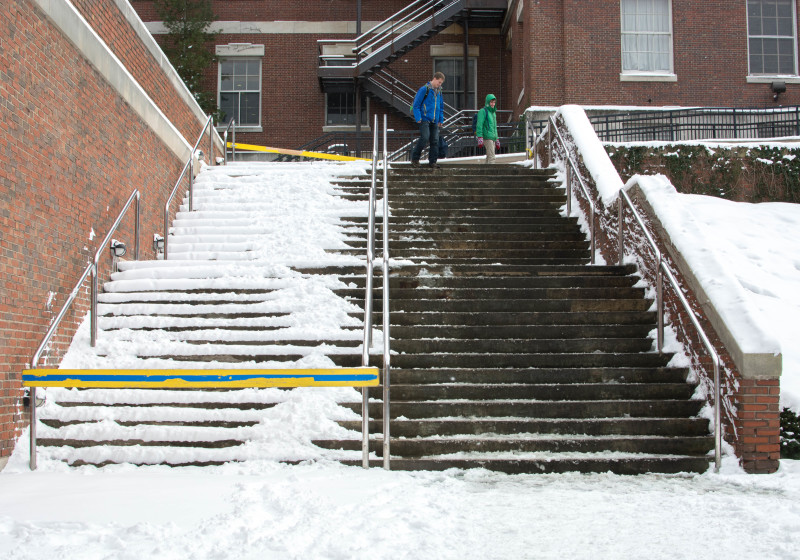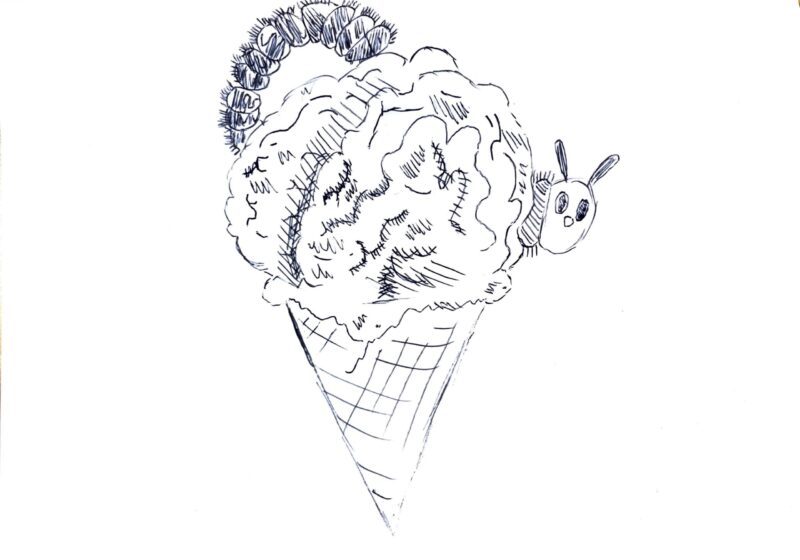I steadied the cup of coffee in my hands as the UR Facilities truck rumbled down the road and looked out at the mountain of snow in the corner of the Med Center parking lot. I tried without success to imagine Ron’s morning, but all I could think about was my own difficulties trying to scrape the ice off my car. Ron’s job was a hundred times harder.
“If there’s snow coming down a couple inches an hour and we’re clearing it away, it’s not always gonna look neat,” said Ron. “The work keeps getting undone, but we keep trying. We do the best we can to make the roads and paths passable for cars and people alike.”
I had spent the past hour riding along with UR Facilities Working Leader Ronald Brown, as he walked me through the different lots and spaces his department is responsible for during the snow removal process. What struck me more than anything was his easy acceptance of an insurmountable problem: the snow always won. A parking lot plowed once could be snow-packed again a few hours later. An early morning call-in for an inch of snowfall might change abruptly into a snowstorm. Snow removal is repetitive, unpredictable, and often unrecognized, but it is a process that thousands of people rely upon every day.
The Horticulture & Grounds department, a support operation under Facilities & Services, is the team that manages the snow and ice removal process the university. Snow is unpredictable, but the snow removal team is not. They begin preparations for the winter season in early autumn, striving each year to improve service from the last. They work under an extensive snow plan, and each workers’ winter schedule is revised from late November to the last week of March to provide on-site 24-hour coverage, Monday through Friday. They frequently check the weather forecast and have off-site monitoring even on the weekends.
Turning into the new children’s hospital, I couldn’t believe how adeptly Ron navigated the tight parking lot in the large snow truck. He didn’t seem to notice the squeeze as he related his morning routine. “When we get a call to come in, we all know what we usually do,” he said. “We’ll come in sometime between two and three in the morning. People start arriving for work at daybreak, so it’s very important that we make sure everyone has a spot to park their car by that time.”
This is especially critical at the Medical Center. As the largest employer in Rochester, every parking spot is necessary. Some people get bused in from another parking lot a few miles away, and some parking lots have three-deep car parking. In the tighter lots, it is essential that the snow is cleared away as much as possible, because people are boxed into exact spots, and the parking attendant must space the cars perfectly to fit everyone in the lot.
According to Dave Nelson, Acting Manager of Horticulture & Grounds, the time and workforce needed to clear away the snowfall “greatly depends on the amount and type of precipitation.” Reliably, however, “it takes anywhere between 10-15 staff to completely clear the River Campus’ roadways, sidewalks, entryways, and parking lots.”
The first priority in snow removal is to clear the roadways on both the River Campus and the Medical Center, ensuring the safe passage of emergency vehicles and trades staff. For the Medical Center, specifically, the Emergency Department and ambulance drop-off are the two most essential areas to cover.
“Perhaps the greatest challenge that we are confronted with is preparing for the unpredictability of lake-effect snow that is so prevalent in our area,” Nelson said. “Narrow bands of lake effect snow could mean the difference between accumulating less than an inch of snow in one area and several inches only a few miles away.”
Unpredictability contributes to the secondmost significant challenge that they face: the variable amount of pedestrian and vehicular traffic during a snow event. It is significantly easier to clear away the snow if it comes earlier in the morning or the night before so that the team has time to plow and salt everything. Once the cars are parked, there’s not a lot they can do without plowing-in the vehicles.
In the truck, Ron motioned toward a big yellow tractor off in the corner of one of the lots. “That’s one of the tractors we use when there is too much snow for the pickup trucks to manage,” he said. He then listed off the variety of vehicles they use to clear away snowfall on campus. “We mainly use pickup trucks for the roads, but we also use big payloaders, tractors with plows, machines with brooms on them to clean the sidewalks, and salters that follow the tractors.”
Different areas require different tools. Sidewalks are cleared with different vehicles than parking lots, and those parking lots have different requirements for what plows can be used on their surfaces. Near the Saunders Research Building, the parking lot is made of a porous pavement that absorbs and drains water that collects on it. Its surface is more sensitive, so only plows with a rubber edge can be used on it; older parking lots can take the standard metal-plated plows.
The type of snow also makes a difference. It is easier to clear away powdered snow than heavy, wet snow, but powdered snow is subject to wind drift. There are places on campus that must be constantly checked on during the day, because the wind so frequently blows it off the roofs.
If that wasn’t enough for a team of 10-15 to manage, every doorway must be cleared, loading docks and handicapped ramps need to be accessible, and even garage rooftops have to be emptied, as they cannot reliably support the weight of both cars and snow.
There is understandable logic behind the mysterious staircase phenomenon—the point, each year, when half of the outdoor staircases are blocked off and left untouched all winter. It is a cogent effort to prioritize the process of clearing snow from campus. With so much ground to cover, the snow removal team has a plan for working as efficiently as possible in every place on campus.
“We think of our snow removal crews as the ‘first responders’,” Nelson said. “On-call 24/7 during the winter season, our dedicated staff is frequently called in late at night and in the early morning hours, traveling in hazardous conditions on their way into the University, to begin the process of removing snow and applying salt. During major events, our staff remains on duty until the event is over.”
“As one could imagine, removing snow and ice in a short amount of time throughout the various University campuses, to include clearing more than 65 emergency egresses, can be a herculean effort.” To put it simply, if the governor declared a state of emergency due to snow and no unnecessary travel was allowed, the snow removal crew would still be here working, clearing the snow, and keeping the University passable for cars and people alike.





